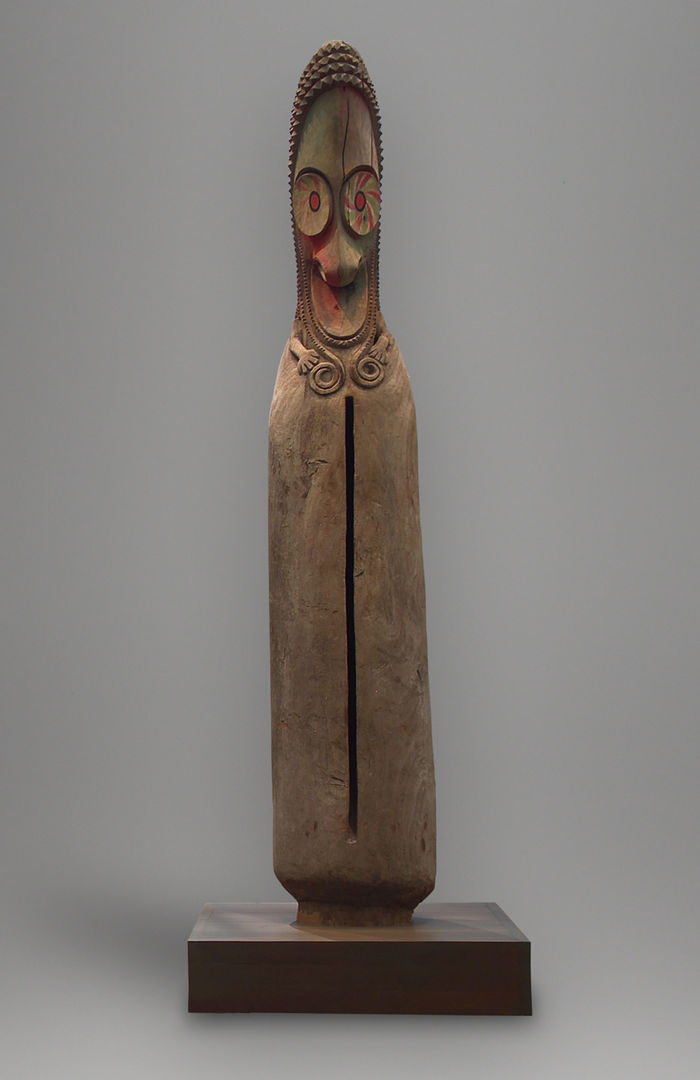Voices of the Past

Commissioned by Tain Mal, carved by Tin Mweleun (active 1960s). Slit gong (atingting kon), mid- to late 1960s. Vanuatu, Ambrym Island, Fanla village. Wood, paint, H. 168 in. (430 cm). The Metropolitan Museum of Art, New York, Purchase, Rogers Fund, 1975 (1975.93)
Collection Area: Oceanic Art
Subject Areas: English Language Arts, Music, Technology, Visual Arts, World History
Grades: Elementary School, Middle School
Topics/Themes: Communities, Artist Choices, The Art of Belief
Goals
Students will be able to:
- identify the function of this object in its original context;
- compare and contrast the way communities around the world engage with their elders; and
- analyze the physical and emotional impact of scale in works of art.
National Learning Standards
English Language Arts
NL-ENG. K-12. 4 Communication Skills
NL-ENG. K-12. 5 Communication Strategies
NL-ENG. K-12. 9 Multicultural Understanding
NL-ENG. K-12. 10 Applying Non-English Perspectives
Music
NA. 5-8. 9 Understanding Music in Relation to History and Culture
Technology
NT. K-12. 4 Technology Communications Tools
World History
NSS-WH. 5-12. 9 Era 9: The 20th Century Since 1945: Promises and Paradoxes
Visual Arts
NA-VA. K-12. 3 Choosing and Evaluating a Range of Subject Matter, Symbols, and Ideas
NA-VA. K-12. 4 Understanding the Visual Arts in Relation to History and Cultures
NA-VA. K-12. 6 Making Connections between Visual Arts and Other Disciplines
Common Core State Standards
English Language Arts
CCSS. ELA-Literacy. CCRA. R. 6 Assess how point of view or purpose shapes the content and style of a text. *
CCSS. ELA-Literacy. CCRA. SL. 1 Prepare for and participate effectively in a range of conversations and collaborations with diverse partners, building on others' ideas and expressing their own clearly and persuasively.
CCSS. ELA-Literacy. CCRA. SL. 2 Integrate and evaluate information presented in diverse media and formats, including visually, quantitatively, and orally.
CCSS. ELA-Literacy. CCRA. SL. 5 Make strategic use of digital media and visual displays of data to express information and enhance understanding of presentations.
*Art as text
Questions for Viewing
- Take a moment to look closely. What do you notice?
- This object was made in Melanesia from the wood of a breadfruit tree. How might it feel if you touched it?
- How might the impact of this work change if you could fit it in your pocket? Why do you think the artist made it so large?
- This object, called a slit gong (or slit drum), is a musical instrument played on special occasions such as dances, initiations, and funerals. What special occasions do you honor in your community? What type of music, clothing, or food is associated with each occasion?
- Gongs like this one are also used as methods of communication between villages. How might you use this instrument to convey a range of messages?
- The gong represents an ancestor. When the instrument is struck, his or her voice comes out of the long, narrow mouth. What might this object tell us about the community’s feelings or ideas about their ancestors?
- What role do ancestors play in your community?
Activity
Activity Setting: Classroom
Materials: Audio recordings of oral histories from your community, paper, pencil, and audio recording device
Subject Areas: English Language Arts, Technology, Visual Arts, World History
Duration: 120 minutes
Listen to oral history recordings to hear the voices of ancestors from your community. What do you have in common with these individuals? How do their actions and ideas influence life today? Create a list of questions to use as a basis for an interview with an elder member of your community. Record your interview and share your observations with your peers.
Resources
"Commissioned by Tain Mal, carved by Tin Mweleun: Slit Gong (Atingting Kon) (1975. 93). " In Heilbrunn Timeline of Art History. New York: The Metropolitan Museum of Art, 2000–. (January 2010)
Kjellgren, Eric. "Musical Instruments of Oceania. " In Heilbrunn Timeline of Art History. New York: The Metropolitan Museum of Art, 2000–. (January 2010)
Sounding the Pacific: Musical Instruments of Oceania, on view at The Met Fifth Avenue, November 17, 2009, through January 23, 2011.
Objects in the Museum's Collection Related to this Lesson
Slit Gong (Waken), 19th–early 20th century. Papua New Guinea, Middle Sepik region, Komindimbit village. Iatmul. Wood; L. 152 in. (386 cm). The Metropolitan Museum of Art, New York, The Michael C. Rockefeller Memorial Collection, Purchase, Nelson A. Rockefeller Gift, 1968 (1978. 412. 1536)
Friction Drum (Lunet or Livika), late 19th–early 20th century. New Ireland. Wood, shell, L. 19 1/2 in. (49. 5 cm). The Metropolitan Museum of Art, New York, The Michael C. Rockefeller Memorial Collection, Bequest of Nelson A. Rockefeller, 1979 (1979. 206. 1477)
Author: Claire Moore; affiliation: The Metropolitan Museum of Art, 2010